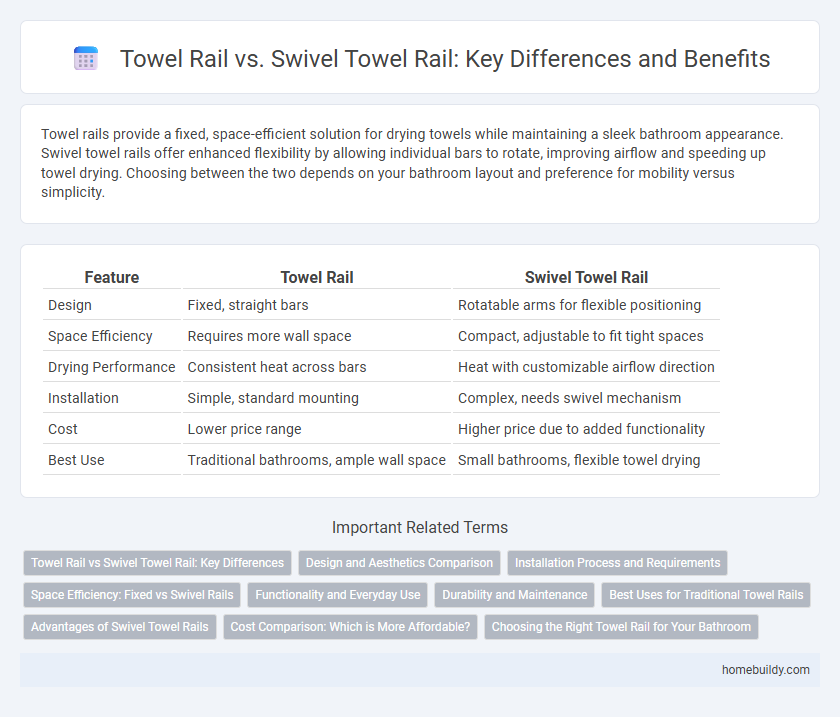Towel rails provide a fixed, space-efficient solution for drying towels while maintaining a sleek bathroom appearance. Swivel towel rails offer enhanced flexibility by allowing individual bars to rotate, improving airflow and speeding up towel drying. Choosing between the two depends on your bathroom layout and preference for mobility versus simplicity.
Table of Comparison
| Feature | Towel Rail | Swivel Towel Rail |
|---|---|---|
| Design | Fixed, straight bars | Rotatable arms for flexible positioning |
| Space Efficiency | Requires more wall space | Compact, adjustable to fit tight spaces |
| Drying Performance | Consistent heat across bars | Heat with customizable airflow direction |
| Installation | Simple, standard mounting | Complex, needs swivel mechanism |
| Cost | Lower price range | Higher price due to added functionality |
| Best Use | Traditional bathrooms, ample wall space | Small bathrooms, flexible towel drying |
Towel Rail vs Swivel Towel Rail: Key Differences
Towel rails provide a fixed, horizontal bar for hanging towels, offering a sleek and space-saving design ideal for standard bathroom layouts. Swivel towel rails feature adjustable arms that rotate independently, enhancing flexibility and allowing towels to dry faster by improving air circulation. Choosing between the two depends on bathroom size, user preference for convenience, and the need for multi-towel hanging capacity.
Design and Aesthetics Comparison
Towel rails offer a sleek, fixed design that blends seamlessly with minimalist bathroom decor, providing a consistent, streamlined look. Swivel towel rails feature adjustable arms that can rotate independently, adding dynamic form and functionality while creating visual interest through varied angles. The choice between them hinges on whether a static, refined appearance or a versatile, contemporary aesthetic is preferred in bathroom design.
Installation Process and Requirements
Wall-mounted towel rails require a straightforward installation process involving fixed brackets and standard wall anchors, suitable for solid walls or studs that can support the rail's weight. Swivel towel rails feature adjustable arms that rotate independently, demanding precise alignment and hardware to enable smooth movement, often requiring additional wall reinforcement. Both types need proper positioning near heat sources or plumbing for optimal drying efficiency and adherence to safety standards.
Space Efficiency: Fixed vs Swivel Rails
Fixed towel rails offer a compact, streamlined design that maximizes wall space, ideal for narrow bathrooms or limited areas. Swivel towel rails provide adjustable angles, allowing towels to be spread out for faster drying, but require slightly more clearance around the unit. Choosing between fixed and swivel rails depends on balancing optimal space utilization and improved air circulation for damp towels.
Functionality and Everyday Use
Towel rails provide a fixed, space-saving solution ideal for consistent towel drying and organization, offering a sleek and stable design. Swivel towel rails feature adjustable arms that rotate individually, enhancing accessibility and airflow to speed up drying times in varied bathroom layouts. Both types improve bathroom hygiene, but swivel rails offer greater flexibility for everyday use in tight or multi-user spaces.
Durability and Maintenance
Towel rails, typically fixed to walls, offer robust durability with minimal moving parts, resulting in lower maintenance needs over time. Swivel towel rails feature pivoting arms that provide flexibility but may require more frequent checks and upkeep to ensure smooth operation and prevent wear. Choosing between the two depends on balancing the simplicity of fixed designs against the convenience of adjustable, yet potentially higher-maintenance, swivel models.
Best Uses for Traditional Towel Rails
Traditional towel rails provide a fixed, sturdy solution ideal for compact bathrooms where space optimization is essential. Their classic design complements vintage or rustic interiors while efficiently drying multiple towels simultaneously. Unlike swivel towel rails, they require less maintenance and offer a more reliable heat distribution for consistent towel warmth.
Advantages of Swivel Towel Rails
Swivel towel rails offer superior flexibility by allowing each arm to independently pivot, maximizing drying space and improving air circulation for faster towel drying compared to fixed towel rails. Their adjustable design accommodates towels of various sizes and can be folded away to save space when not in use. This versatility makes swivel towel rails an efficient and practical solution for compact bathrooms and laundry areas.
Cost Comparison: Which is More Affordable?
Swivel towel rails generally carry a higher price tag due to their adjustable functionality and more complex installation requirements compared to standard towel rails. Standard towel rails offer a more budget-friendly option with straightforward mounting and fewer moving parts, leading to lower costs in both purchase and maintenance. Choosing between the two depends on balancing the affordability of fixed towel rails against the added convenience and flexibility of swivel designs.
Choosing the Right Towel Rail for Your Bathroom
Choosing the right towel rail depends on your bathroom layout and drying needs; standard fixed towel rails offer a sleek, space-saving design ideal for smaller areas, while swivel towel rails provide greater flexibility with arms that rotate to maximize airflow and faster drying. Swivel models often feature multiple arms, allowing for more towels to be hung simultaneously without overlapping, which reduces dampness and mildew formation. Consider factors like wall space, towel drying efficiency, and ease of use to determine whether a fixed or swivel towel rail best enhances your bathroom's functionality.
Towel rail vs Swivel towel rail Infographic

 homebuildy.com
homebuildy.com